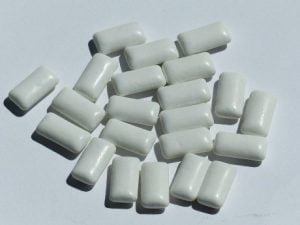What is E 445?
Food additive E 445 acts as a thickener, emulsifier, stabiliser, adjuvant and flavouring. Synonym: ester gum.
Chemically they are mixtures of esters of di- and triglycerol with resin acids from wood (pine) resins.
Industrially, resin is obtained by extracting it from old pine logs using solvents, followed by solvent refining. There are also substances derived from resin gum, an exudate of green pine trees, and substances derived from liquid resin, a by-product of the sulphate paper process. [i]
Definition: A complex mixture of tri- and diglycerol esters of resin acids from rosin extracted from wood. Wood rosin is obtained by solvent extraction of aged pine logs followed by a liquid-liquid solvent refining process. Excluded from this specification are substances derived from rosin gum, from the exudate of green pine trees and substances derived from rosin in tall oil, a by-product of the pulp processing for kraft paper.
Which foods contain the food additive E 445?
Food additive E 445 is used:
- as the base material for chewing gum,
- surface treatment of fresh fruit and vegetables,
- in non-alcoholic flavoured energy drinks,
- in flavoured cloudy alcoholic beverages containing less than 15% alcohol. Drinks containing this additive are not recommended for children,
- confectionery, including breath freshening drops. [ii]
Are there any side effects from consuming the food additive E 445?
In general E445 is considered safe, but no chronic toxicity, carcinogenicity, reproductive and developmental toxicity studies are available.
The additive E 445 can sensitise the skin, but no allergic reactions to foods containing it have been found.[iii]
What are the characteristics of E445?
The final product contains approximately 90 % resin acids and 10 % neutral substances. The resin acids are represented by a mixture of isomeric diterpenoid monocarboxylic acids. They have the crude formula C20 H30 O2 .
According to Commission Regulation (EU) No 231/2012 of 9 March 2012 laying down specifications for food additives listed in Annexes II and III to Regulation (EC) No 1333/2008 of the European Parliament and of the Council, glycerol esters from wood resins must have the following characteristics:
Description: hard, yellow to light brown solid
Solubility Insoluble in water, soluble in acetone
Infrared absorption spectrum
Characteristic of the compound
Purity
Specific gravity of solution [d]20 25 not less than 0,935, determined in a 50 % solution in d-limonene (97 %, boiling temperature 175,5-176 °C, d20 4: 0,84)
Soaking range determined by ring and ball method: Between 82 °C and 90 °C
Acid value Not less than 3 and not more than 9
Hydroxyl value Not less than 15 and not more than 45
Arsenic Not more than 3 mg/kg
Lead Not more than 2 mg/kg
Mercury Not more than 1 mg/kg
Cadmium Not more than 1 mg/kg
Test for the absence of rosin in tall oil (sulphur test): When organic compounds containing sulphur are heated in the presence of sodium formate, sulphur is converted to hydrogen sulphide which can be easily detected with lead acetate paper. A positive test indicates the use of tall oil rosin instead of wood rosin. [iv]
Why is it necessary to use E 445?
As an emulsifier it acts to form and stabilise emulsions by lowering the surface tension between the two immiscible phases. In flavoured beverages, the additive acts to prevent the deposition of particles in suspension, and thus the separation of the phases. In fruit juices it simulates a higher fruit content (accentuates fruit flavour). Due to its weak antiseptic action, the additive is used in the surface treatment of citrus fruits.1
What are food additives?
According to the World Health Organization, substances that are added to food to maintain or improve the safety, freshness, taste, texture or appearance of food are known as food additives. For centuries, food additives have been used to preserve food, for example salt (in meat, bacon or dried fish), sugar (in marmalade) or sulphur dioxide (in wine).
Over the years, many food additives have been developed to meet the needs of food production, because large-scale food manufacturing is much more complex than small-scale home production.
Introducing additives into food is done to ensure that processed foods remain safe and in good condition throughout their journey from factories or industrial kitchens to warehouses and shops and ultimately to consumers.
The use of food additives is only justified when their use has a technological need, does not mislead consumers and serves a well-defined technological function such as preserving the nutritional quality of food or enhancing the stability of food.
Food additives can be derived from plants, animals or minerals, or they can be synthetic. They are intentionally added to food to fulfil certain technological purposes. There are several thousand food additives in use, all of which are designed to perform a specific task, usually to make food more durable or appealing.
How many categories do food additives fall into?
The World Health Organization (WHO)[v] has grouped food additives, based on their function, into 3 broad categories as follows:
- Flavouring agents. These are added to foods to improve flavour or taste. Flavour enhancers are most commonly used in foods. There are hundreds of types of flavourings used in a wide variety of foods, from confectionery and soft drinks to cereals, cakes and yoghurt.
- Enzymes or enzyme preparations. They can be obtained by extraction from plants or animal products or from micro-organisms such as bacteria and are used as alternatives to chemical-based technology.
Enzyme preparations are mainly used in baking (to improve dough), fruit juices, wine and beer making (to improve fermentation) and cheese making (to improve curd formation).
- Other additives. These are used for several reasons, such as: preservation, colouring and sweetening. They are added when food is being prepared, packaged, transported or stored and eventually become a component of the food.
How are food additives assessed for risk?
The World Health Organization (WHO), in cooperation with the Food and Agriculture Organization of the United Nations, are responsible for carrying out risk assessments of food additives. The risk assessment of food additives is carried out by the FAO/WHO Expert Committee on Food Additives (JECFA).
Only food additives that have undergone a JECFA safety assessment and do not pose a health risk to consumers may be used. This applies regardless of whether the food additives come from a natural source or are synthetic. JECFA evaluations are based on scientific analysis of all relevant biochemical, toxicological and other data on a particular additive.
National authorities, either on the basis of the JECFA assessment or on the basis of a national assessment, may then authorise the use of food additives.
The starting point for determining whether a food additive can be used without harm is to establish the acceptable daily intake. The recommended daily intake is an estimate of the amount of additive in food or drinking water that can be safely consumed daily over a lifetime without adverse health effects.
How do we know that foods contain food additives?
According to the World Health Organization, practices, standards and guidelines on food labelling are established globally. These standards are implemented in most countries and food manufacturers are obliged to indicate which additives are in their products. In the European Union, for example, there is legislation governing the labelling of food additives according to a set of pre-defined “E-numbers”. People with allergies or sensitivities to certain food additives should read labels carefully.
The World Health Organization encourages national authorities to monitor and ensure that food additives in foods and beverages produced in their countries comply with the uses, conditions and legislation.
Conclusions and Legislative Regulations E 445
The additive (E445) is listed in Commission Regulation (EU) No 231/2012 as an authorised food additive and classified as ‘other additives than colours and sweeteners’.[vi]
Data from the literature show that so far no definitive assessment of the toxicity of the additive can be made.
Author: dr. ing. Ancuța Fulvia Manolache
Bibliographic references
[i] Elena Orănescu, Food Additives-necessity and risk, SemnE Publishing House, 2005, Bucharest
[ii]Regulation (EC) No 1333/2008 of the European Parliament and of the Council of 16 December 2008 on food additives
[iii] Re-evaluation of glycerol esters of wood rosin (E 445) as a food additive, EFSA Panel on Food Additives and Nutrient Sources added to Food (EFSA ANS Panel), Maged Younes,Peter Aggett,Fernando Aguilar,Riccardo Crebelli,Metka Filipič,Maria Jose Frutos et al, 26 July 2018 https://doi.org/10.2903/j.efsa.2018.5370
[iv] Commission Regulation (EU) No 231/2012 of 9 March 2012 laying down specifications for food additives listed in Annexes II and III to Regulation (EC) No 1333/2008 of the European Parliament and of the Council
[v] https://www.who.int/news-room/fact-sheets/detail/food-additives
[vi] https://eur-lex.europa.eu/legal-content/EN/TXT/?uri=CELEX:02011R1129-20131121
7 https://pixabay.com/ro/photos/guma-de-mestecat-dulcea%c5%a3%c4%83-115163/
8 https://pixabay.com/ro/photos/fructe-proasp%c4%83t-co%c5%9f-1114060/


